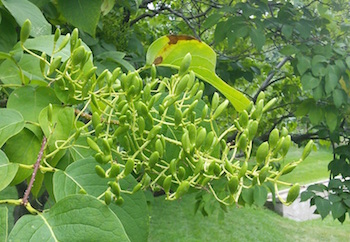
Description:
Japanese tree lilac is a beautiful ornamental tree known for its white flowers. Leaves are dark green, simple, and opposite. They are oval and slightly heartshaped, coming to sharp point at the tip. Flowers bloom in uprgith panicles, or spike-like clusters and are a creamy white color. Female flowers eventually develop into loose clusters of brown seed capsules that can remain on the tree throughout the winter. Young bark is reddish-brown, but turns gray with age.
Japanese tree lilac distinguishes itself from the more common, shrubby lilac (Syringa vulgaris), through its size and later blooms. It is a popular landscape tree due to these factors, and can be seen in many gardens across the world, and is also a popular street and border tree. The flowers are not as strong smelling as those of common lilacs, and instead smell more like the flowers of a privet.
Issues:
Japanese tree lilac is more resistant to disease than the common lilac, but is still susceptible to numerous pests. See below for more information.
Other Resources:
UMN Extension--Diseases of Japanese Tree Lilac
Photo Credit: David Stang CC by SA 3.0






